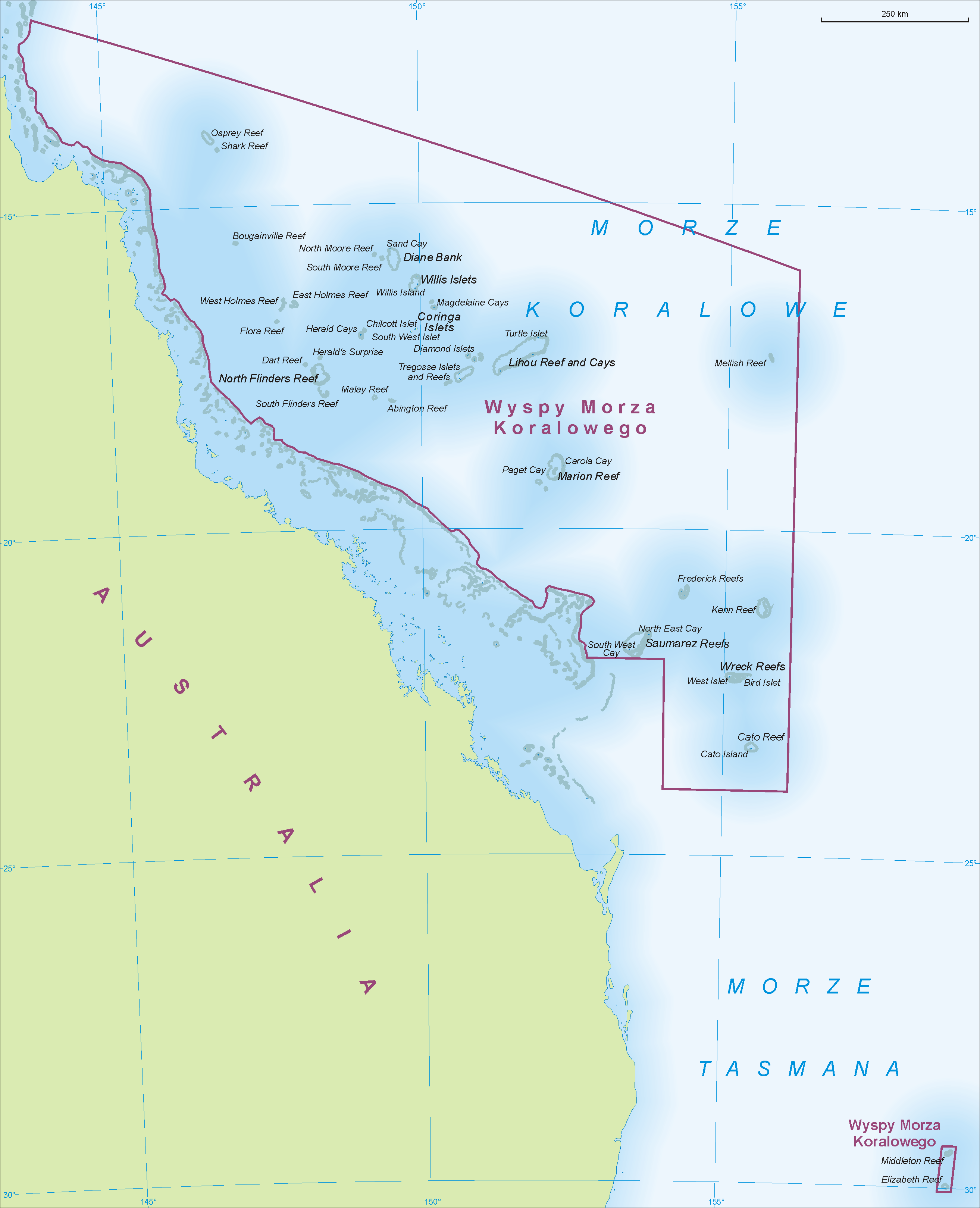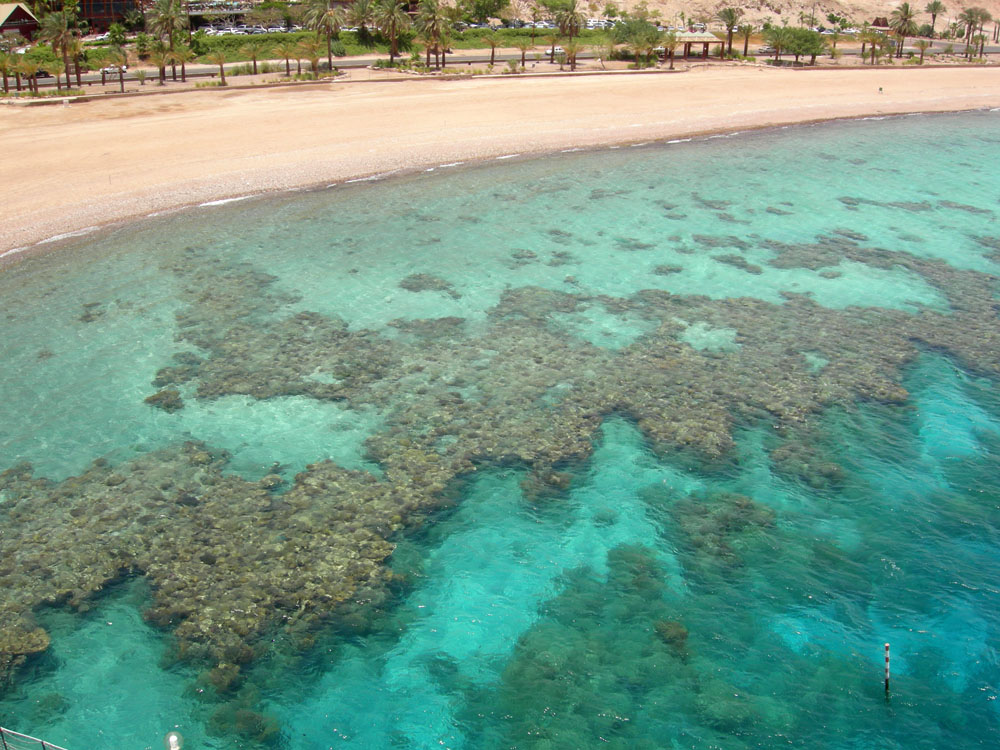|
Flinders Reef (Coral Sea)
Flinders Reef or Flinders Reefs is an isolated oceanic coral reef in the Coral Sea of the western Pacific Ocean. It lies east of Australia and the extensive Great Barrier Reef. Due to its remote location, it remains poorly studied. However, this isolation has also made it a potential site to Global Boundary Stratotype Section and Point, mark the beginning of the Anthropocene. Location Flinders Reef is one of a number of oceanic reefs rising from the Queensland plateau. It lies near the southwest edge, with the Queensland trough to the west separating it from the Great Barrier Reef, and the Townsville trough to the south separating it from the Marion plateau. It is from the Great Barrier Reef, and northeast of the Australian coastline. The position of the reef is around 17°37'S, 148°31'E, with weather station Cay located at 17°44'S, 148°26'E. This area falls within the Coral Sea, which has a tropical climate and high rainfall. Water currents around the reef tend to originat ... [...More Info...] [...Related Items...] OR: [Wikipedia] [Google] [Baidu] |
Reef Flat
A fringing reef is one of the three main types of coral reef. It is distinguished from the other main types, barrier reefs and atolls, in that it has either an entirely shallow backreef zone (lagoon) or none at all. If a fringing reef grows directly from the shoreline, then the reef flat extends to the beach and there is no backreef. In other cases (e.g., most of the Bahamas), fringing reefs may grow hundreds of yards from shore and contain extensive backreef areas within which it contains food and water, examples are Philippines, Indonesia, Timor-Leste, the western coast of Australia, the Caribbean, East Africa, and Red Sea. Charles Darwin believed that fringing reefs are the first kind of reefs to form around a landmass in a long-term reef growth process.Kennedy, D.M. and Woodroffe, C.D. 2002.Fringing reef growth and morphology: a review. ''Earth-Science Reviews''. 57:255-277. The largest fringing coral reef in the world is the Ningaloo Reef, stretching to around along the coas ... [...More Info...] [...Related Items...] OR: [Wikipedia] [Google] [Baidu] |
Cyanobacteria
Cyanobacteria (), also known as Cyanophyta, are a phylum of gram-negative bacteria that obtain energy via photosynthesis. The name ''cyanobacteria'' refers to their color (), which similarly forms the basis of cyanobacteria's common name, blue-green algae, although they are not usually scientifically classified as algae. They appear to have originated in a freshwater or terrestrial environment. Sericytochromatia, the proposed name of the paraphyletic and most basal group, is the ancestor of both the non-photosynthetic group Melainabacteria and the photosynthetic cyanobacteria, also called Oxyphotobacteria. Cyanobacteria use photosynthetic pigments, such as carotenoids, phycobilins, and various forms of chlorophyll, which absorb energy from light. Unlike heterotrophic prokaryotes, cyanobacteria have internal membranes. These are flattened sacs called thylakoids where photosynthesis is performed. Phototrophic eukaryotes such as green plants perform photosynthesis in plast ... [...More Info...] [...Related Items...] OR: [Wikipedia] [Google] [Baidu] |
Phototropism
Phototropism is the growth of an organism in response to a light stimulus. Phototropism is most often observed in plants, but can also occur in other organisms such as fungi. The cells on the plant that are farthest from the light contain a hormone called auxin that reacts when phototropism occurs. This causes the plant to have elongated cells on the furthest side from the light. Phototropism is one of the many plant tropisms or movements which respond to external stimuli. Growth towards a light source is called positive phototropism, while growth away from light is called negative phototropism. Negative phototropism is not to be confused with skototropism which is defined as the growth towards darkness, whereas negative phototropism can refer to either the growth away from a light source or towards the darkness. Most plant shoots exhibit positive phototropism, and rearrange their chloroplasts in the leaves to maximize photosynthetic energy and promote growth.Goyal, A., Szarzyns ... [...More Info...] [...Related Items...] OR: [Wikipedia] [Google] [Baidu] |
Dictyonella (sponge)
''Dictyonella'' is a genus of sponges belonging to the family Dictyonellidae. The genus has almost cosmopolitan distribution In biogeography, cosmopolitan distribution is the term for the range of a taxon that extends across all or most of the world in appropriate habitats. Such a taxon, usually a species, is said to exhibit cosmopolitanism or cosmopolitism. The ext .... Species: *'' Dictyonella alonsoi'' *'' Dictyonella arenosa'' *'' Dictyonella chlorophyllacea'' *'' Dictyonella conglomerata'' *'' Dictyonella foliaformis'' *'' Dictyonella funicularis'' *'' Dictyonella hirta'' *'' Dictyonella incisa'' *'' Dictyonella madeirensis'' *'' Dictyonella marsilii'' *'' Dictyonella obtusa'' *'' Dictyonella pelligera'' References {{Taxonbar, from=Q4115870 Heteroscleromorpha Sponge genera ... [...More Info...] [...Related Items...] OR: [Wikipedia] [Google] [Baidu] |
Carteriospongia
''Carteriospongia'' is a genus of sea sponges in the family Thorectidae. There is some debate around the taxonomy of the group, with a 2021 molecular and morphological assessment of the subfamily Phyllospongiinae suggesting that ''Carteriospongia'' should become a synonym of ''Phyllospongia'', and reinstating Carteriospongia flabellifera to its original designation of Polyfibrospongia flabellifera. The same study described 2 new species, designated ''Phyllospongia bergquistae'' sp. nov. and ''Polyfibrospongia kulit'' sp. nov.. Species * '' Carteriospongia contorta'' Bergquist, Ayling & Wilkinson, 1988 * '' Carteriospongia delicata'' Pulitzer-Finali, 1982 * '' Carteriospongia fissurella'' ( de Laubenfels, 1948) * '' Carteriospongia foliascens'' (Pallas, 1766) * '' Carteriospongia mystica'' Hyatt, 1877 * '' Carteriospongia pennatula'' (Lamarck, 1813) * '' Carteriospongia perforata'' Hyatt Hyatt Hotels Corporation, commonly known as Hyatt Hotels & Resorts, is an American m ... [...More Info...] [...Related Items...] OR: [Wikipedia] [Google] [Baidu] |
Thorectidae
Thorectidae is a family of sea sponges in the order Dictyoceratida Dictyoceratida is an order of sponges in the subclass Ceractinomorpha containing five families. Along with the Dendroceratida, it is one of the two orders of demosponges that make up the keratose or "horny" sponges, in which a mineral skeleton is .... Genera *Subfamily Phyllospongiinae Keller, 1889Keller, C. (1889). Die Spongienfauna des rothen Meeres (1. Hälfte). ''Zeitschrift für Wissenschaftliche Zoologie'', 48, 311–405. **'' Candidaspongia'' Bergquist, Sorokin & Karuso, 1999Bergquist, P., Sorokin, S. & Karuso, P. (1999). Pushing the boundaries: a new genus and species of Dictyoceratida. ''Memoirs of the Queensland Museum'', 44, 57–62. **'' Carteriospongia'' Hyatt, 1877Hyatt, A. (1877). ''Revision of the North American Poriferæ; with Remarks upon Foreign Species''. Boston: Society of Natural History. **'' Lendenfeldia'' Bergquist, 1980Bergquist, P. R. (1960). A revision of the supraspecific classificat ... [...More Info...] [...Related Items...] OR: [Wikipedia] [Google] [Baidu] |
Dictyoceratida
Dictyoceratida is an order of sponges in the subclass Ceractinomorpha containing five families. Along with the Dendroceratida, it is one of the two orders of demosponges that make up the keratose or "horny" sponges, in which a mineral skeleton is minimal or absent and a skeleton of organic fibers containing spongin, a collagen Collagen () is the main structural protein in the extracellular matrix found in the body's various connective tissues. As the main component of connective tissue, it is the most abundant protein in mammals, making up from 25% to 35% of the whol ...-like material, is present instead. References External links Sponge orders {{demosponge-stub ... [...More Info...] [...Related Items...] OR: [Wikipedia] [Google] [Baidu] |
Sponge
Sponges, the members of the phylum Porifera (; meaning 'pore bearer'), are a basal animal clade as a sister of the diploblasts. They are multicellular organisms that have bodies full of pores and channels allowing water to circulate through them, consisting of jelly-like mesohyl sandwiched between two thin layers of cells. Sponges have unspecialized cells that can transform into other types and that often migrate between the main cell layers and the mesohyl in the process. Sponges do not have nervous, digestive or circulatory systems. Instead, most rely on maintaining a constant water flow through their bodies to obtain food and oxygen and to remove wastes. Sponges were first to branch off the evolutionary tree from the last common ancestor of all animals, making them the sister group of all other animals. Etymology The term ''sponge'' derives from the Ancient Greek word ( 'sponge'). Overview Sponges are similar to other animals in that they are multicellular, he ... [...More Info...] [...Related Items...] OR: [Wikipedia] [Google] [Baidu] |
Recreational Diving
Recreational diving or sport diving is diving for the purpose of leisure and enjoyment, usually when using scuba equipment. The term "recreational diving" may also be used in contradistinction to "technical diving", a more demanding aspect of recreational diving which requires more training and experience to develop the competence to reliably manage more complex equipment in the more hazardous conditions associated with the disciplines. Breath-hold diving for recreation also fits into the broader scope of the term, but this article covers the commonly used meaning of ''scuba diving for recreational purposes, where the diver is not constrained from making a direct near-vertical ascent to the surface at any point during the dive'', and risk is considered low. The equipment used for recreational diving is mostly open circuit scuba, though semi closed and fully automated electronic closed circuit rebreathers may be included in the scope of recreational diving. Risk is managed by tra ... [...More Info...] [...Related Items...] OR: [Wikipedia] [Google] [Baidu] |
Coral Bleaching
Coral bleaching is the process when corals become white due to various stressors, such as changes in temperature, light, or nutrients. Bleaching occurs when coral polyps expel the zooxanthellae (dinoflagellates that are commonly referred to as algae) that live inside their tissue, causing the coral to turn white. The zooxanthellae are photosynthetic, and as the water temperature rises, they begin to produce reactive oxygen species. This is toxic to the coral, so the coral expels the zooxanthellae. Since the zooxanthellae produce the majority of coral colouration, the coral tissue becomes transparent, revealing the coral skeleton made of calcium carbonate. Most bleached corals appear bright white, but some are blue, yellow, or pink due to pigment proteins in the coral. The leading cause of coral bleaching is rising ocean temperature due to climate change. A temperature about 1 °C (or 2 °F) above average can cause bleaching. According to the United Nations Environment Pr ... [...More Info...] [...Related Items...] OR: [Wikipedia] [Google] [Baidu] |





